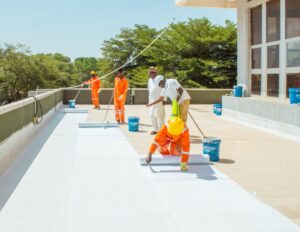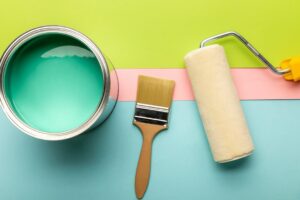Introduction
Achieving a flawless paint finish isn’t just about choosing the perfect color or using quality paint; the secret to a professional, long-lasting finish lies in the preparation work. Skipping or rushing the prep process can lead to uneven coats, peeling, or chipping, and an overall less-than-satisfactory look.
Proper prep work ensures that paint adheres correctly, looks smooth, and stays pristine for years to come. This guide will walk you through the importance of each step in the prep process and how each stage contributes to that flawless, professional finish you desire.
1. Understanding the Importance of Prep Work
Prep work in painting is like laying a foundation for a building. Just as a strong foundation is necessary to keep a structure standing tall, thorough preparation is essential for a lasting paint job. Here’s why prep work is a crucial part of any successful painting project:
- Better Adhesion: A clean, smooth surface helps paint adhere better, reducing the risk of peeling or flaking. Properly prepared walls are easier to paint and produce a more even coat.
- Enhanced Durability: Prep work helps paint withstand daily wear and tear, making it more resistant to stains, scratches, and environmental factors.
- Smooth Finish: By addressing imperfections before painting, you’ll ensure a smooth, professional finish without lumps, bumps, or cracks.
- Cost and Time Efficiency: Taking the time to prep your surfaces means fewer paint layers are required and minimizes the likelihood of needing touch-ups later.
2. Key Steps in Prep Work for a Flawless Finish
Achieving a professional-quality paint finish requires attention to detail in each prep step. Let’s break down each stage, from surface cleaning to priming, and explore how to do each step correctly.
Step 1: Cleaning the Surface
Before applying any paint, ensure that the surface is clean, as dust, dirt, and grime can prevent the paint from sticking properly. This step applies to all surfaces, including walls, ceilings, and trim.
- Walls and Ceilings: Use a mild detergent or a trisodium phosphate (TSP) cleaner to remove any dirt, grease, or stains. Rinse thoroughly with clean water to avoid residue buildup.
- Wood Surfaces: Clean wood surfaces with a soft brush or cloth to remove dust and dirt, and avoid abrasive cleaners that can damage the finish.
- Metal Surfaces: Metal surfaces can have oils from handling. Use a solvent-based cleaner to degrease and wipe down with a lint-free cloth.
Tip: Always allow surfaces to dry completely after cleaning before moving on to the next step.
Step 2: Repairing Damages
Imperfections such as holes, cracks, or dents can be magnified after painting. Properly repair these areas for a smooth, polished finish.
- Filling Holes and Cracks: Use spackle or a joint compound to fill any small holes, cracks, or dents. Apply with a putty knife and smooth it out. For larger holes, use a patching kit.
- Sanding Repairs: Once the filler is dry, sand the area with fine-grit sandpaper (180-220 grit) to ensure a smooth, level surface.
- Addressing Water Damage: If there are signs of water damage, such as peeling paint or mold, address the cause of the damage first and allow the area to dry completely.
Tip: Don’t skip the step of sanding after repairs, as it helps blend repaired areas with the rest of the surface for a seamless finish.
Step 3: Sanding the Surface
Sanding creates a smooth surface for paint application by removing rough spots and improving paint adhesion. Here’s how to do it properly:
- Types of Sandpaper: Use medium-grit sandpaper (120-150) for the initial sanding, then move to finer sandpaper (220-240) for finishing.
- Sanding Technique: Sand in circular motions for even results, and always sand repaired areas for consistency.
- Clean Up Dust: After sanding, vacuum or wipe the surface with a damp cloth to remove dust. Use a tack cloth for a final wipe-down to ensure a dust-free surface.
Tip: For best results, wear a dust mask while sanding to avoid inhaling particles, especially if dealing with older paints that may contain lead.
Step 4: Taping and Masking
Taping and masking are essential for clean lines and protecting areas you don’t want to paint.
- Use High-Quality Painter’s Tape: A quality tape prevents paint bleed and makes for crisper lines. Apply tape around trim, baseboards, light switches, and any edges where you want a precise line.
- Proper Application Technique: Press down firmly along the edges of the tape to ensure adhesion, and remove the tape slowly at a 45-degree angle once the paint is dry to the touch.
Tip: For a seamless finish, run a putty knife along the edge of the tape after applying it to prevent paint seepage.
Step 5: Priming the Surface
Priming is essential for creating a uniform base and enhancing paint adhesion. Here’s how to choose the right primer and apply it properly:
- When to Prime: Prime when painting over bare drywall, wood, or metal, as well as when painting over dark or contrasting colors.
- Choosing the Right Primer: Use a stain-blocking primer for surfaces with stains or odors, a moisture-resistant primer for bathrooms and kitchens, and a wood primer for bare wood.
- Applying Primer: Apply primer evenly using a roller or brush, starting with one thin layer. Allow it to dry completely before applying paint.
Tip: If your paint has a built-in primer, it may work for walls in good condition, but a dedicated primer often delivers better coverage and durability.
3. Additional Tips for Achieving a Professional Finish
Beyond these essential prep steps, additional details can elevate your paint job to the next level:
- Temperature and Humidity Control: For optimal paint application, maintain a room temperature between 10-30°C (50-85°F) and a humidity level of 40-60%.
- Proper Lighting: Ensure good lighting when prepping and painting to spot imperfections.
- Multiple Thin Coats: Applying multiple thin coats of paint is more effective and longer-lasting than a single heavy coat. Allow each coat to dry completely before applying the next.
4. Why Skipping Prep Can Lead to Common Paint Issues
Skipping or rushing through prep work can lead to a range of paint issues that detract from the final look and reduce the durability of the paint. Here are some common problems caused by insufficient prep:
- Peeling and Flaking: This can occur if the surface wasn’t cleaned or primed properly, resulting in poor paint adhesion.
- Bubbling and Blistering: High humidity, applying paint on dirty surfaces, or inadequate primer can cause bubbles to form under the paint, leading to peeling.
- Streaks and Uneven Coverage: If the surface isn’t sanded or if primer isn’t applied, the paint may appear streaky or patchy.
- Visible Imperfections: Small dents, holes, or cracks that aren’t filled and sanded before painting will be magnified by paint, detracting from the smooth finish.
5. Choosing the Right Tools for Prep Work
Using high-quality tools ensures you can complete each step accurately and efficiently. Here’s a list of must-have tools:
- Dust Cloth and Tack Cloth: For cleaning dust off surfaces after sanding.
- Painter’s Tape: Ensures sharp edges and protects trim.
- Putty Knife: For applying spackling or filler to small holes and dents.
- Sandpaper (Various Grits): Use a variety of sandpaper types to achieve a smooth surface.
- Quality Primer: Essential for surfaces with stains, high contrast, or moisture exposure.
- Brushes and Rollers: Choose high-quality brushes and rollers suited to your paint and primer for a smooth, even application.
Final Thoughts:
Why Prep Work is Worth the Effort
The prep work may seem time-consuming, but each step is an investment in the final outcome. With a clean, smooth, and well-prepared surface, you’ll be able to apply paint that looks even, feels smooth, and lasts longer.
Whether it’s a DIY project or a professional endeavor, paying attention to these prep details sets the foundation for a truly flawless, professional-quality finish that can elevate any space.
The bottom line: never underestimate the power of good prep work when it comes to painting. Following these steps carefully will help you achieve the best possible results, with a finish that looks just as good years from now as it does on day one. Get in touch





